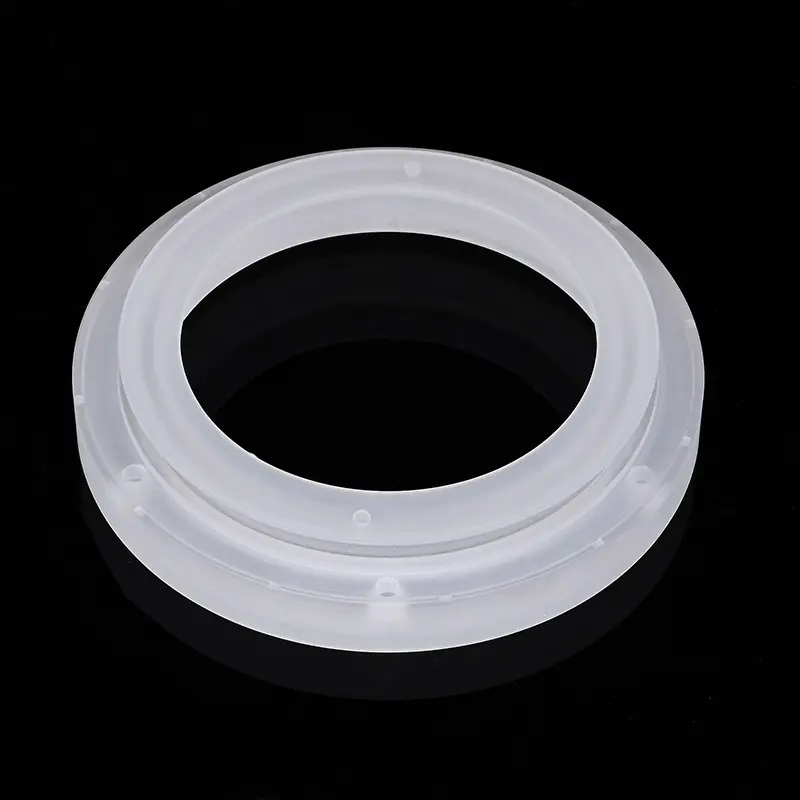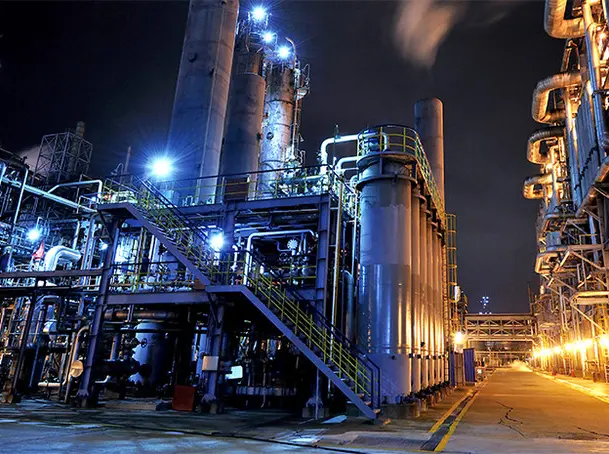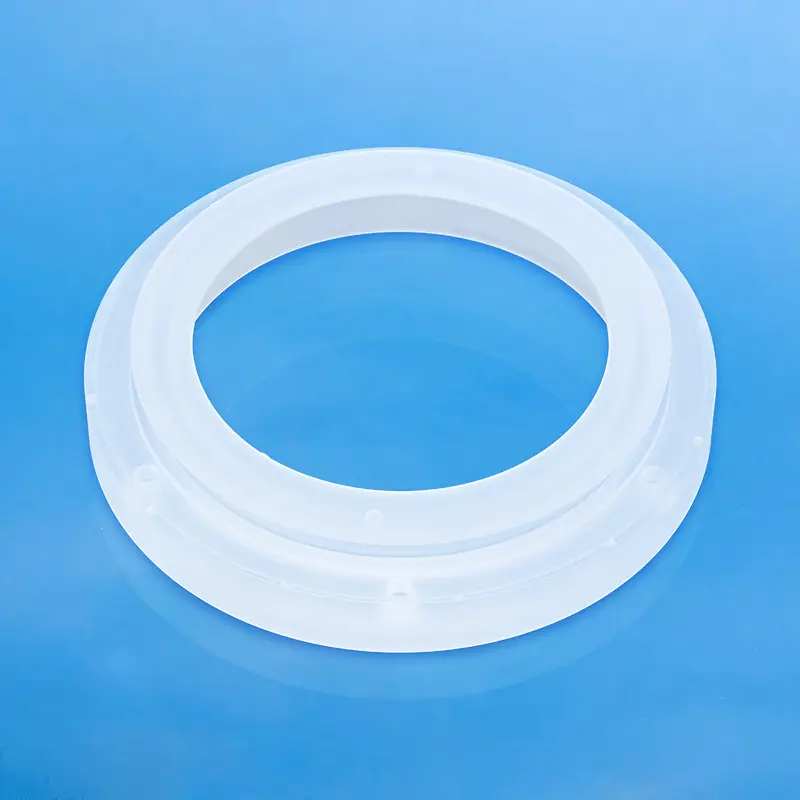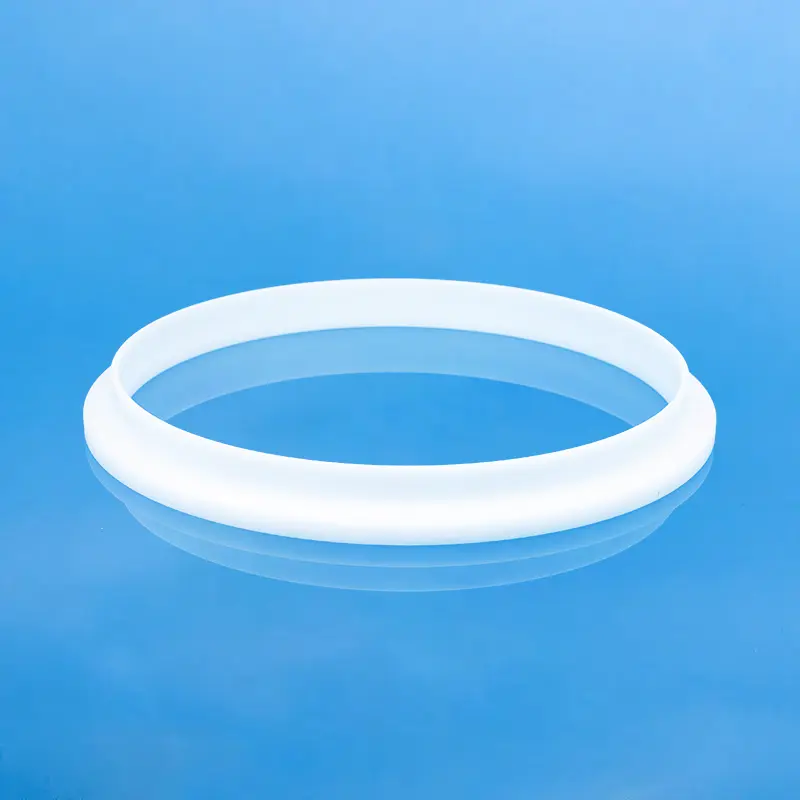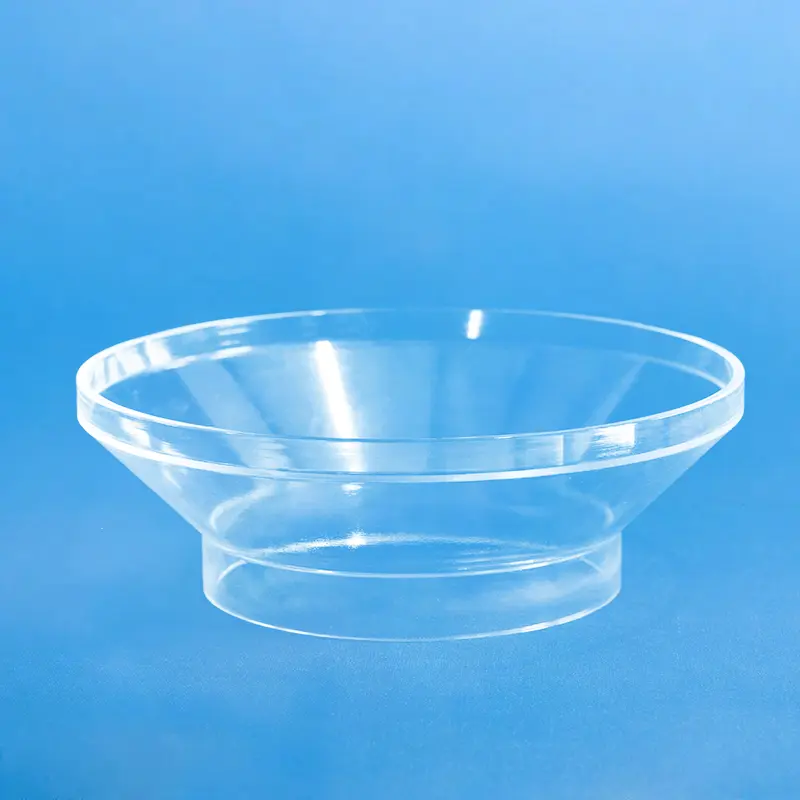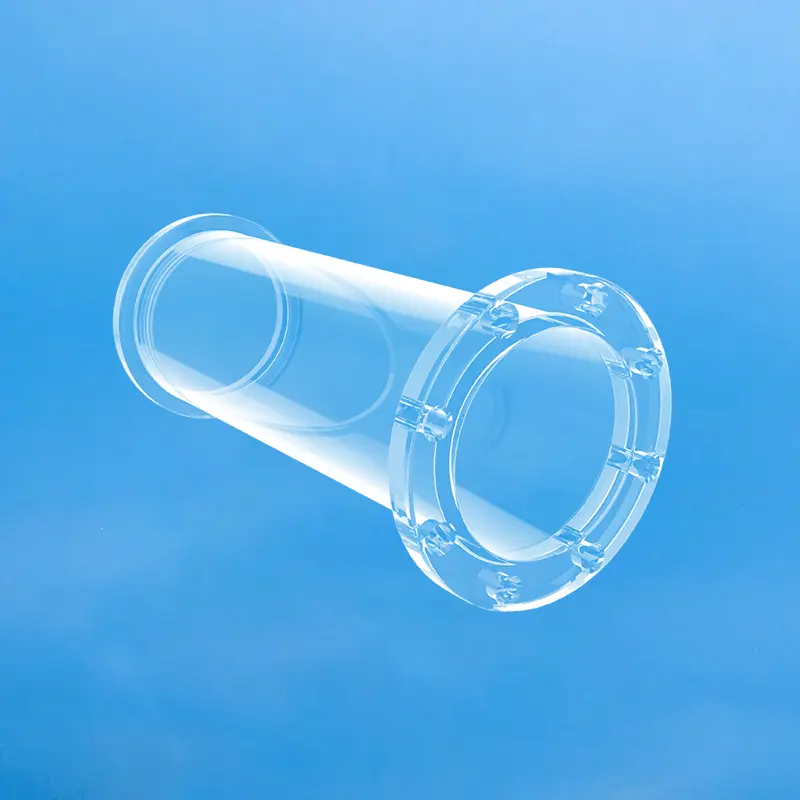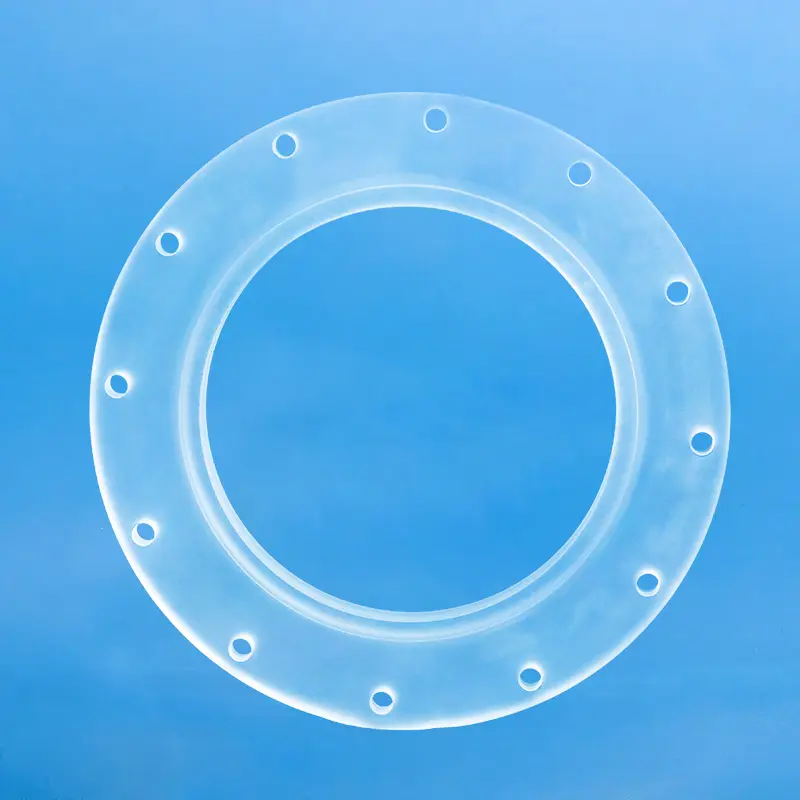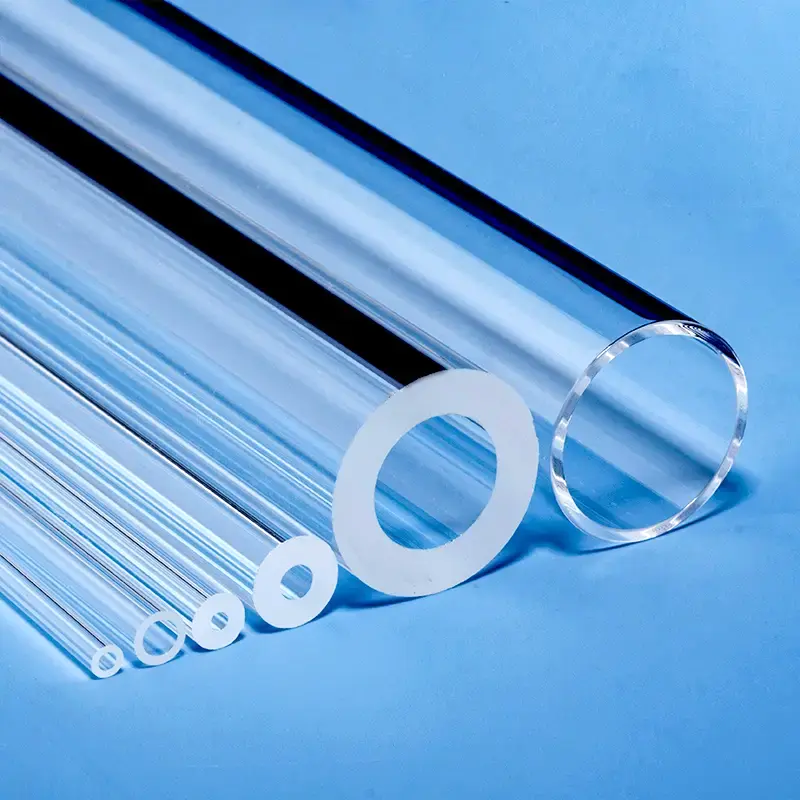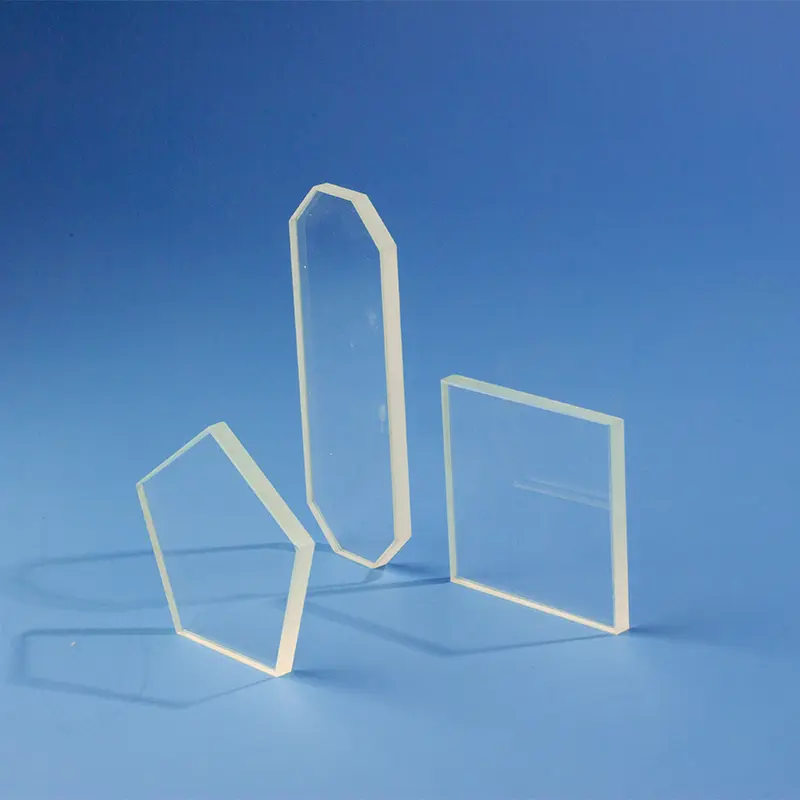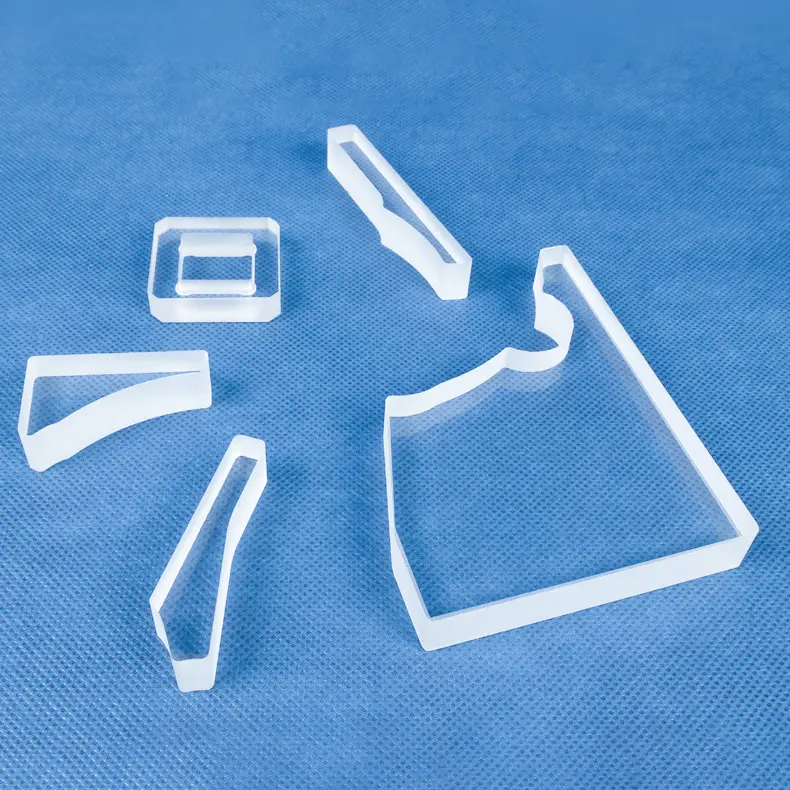Unsere Quarzflansche, auch als Quarzglasflansche bekannt, sind präzisionsgefertigt für kritische Anwendungen, die extreme Reinheit, hohe Temperaturbeständigkeit und Vakuumkompatibilität erfordern. Ideal für Halbleiter-, Optik- und Laborgeräte, gewährleisten sie zuverlässige, korrosionsbeständige Verbindungen. Kundenspezifische Designs sind erhältlich, um Ihre genauen Spezifikationen zu erfüllen.
| Eigenschaftsinhalt | Eigenschaftswerte |
|---|---|
| SiO2 | 99.99% |
| Dichte | 2,2×10³ kg/cm³ |
| Härte | Mohs-Härte 5,5 - 6,5; Knoop-Härte 570 (bei 100 g Prüflast) |
| Zugfestigkeit | 4,8 × 10⁷ Pa (48 N/mm² bzw. 48 MPa); 7.000 psi |
| Druckfestigkeit | >1.1×10⁹ Pa (160,000 psi) |
| Wärmeausdehnungskoeffizient | 5.5×10⁻⁷ cm/cm·°C (20°C-320°C) |
| Wärmeleitfähigkeit | 1,4 W/m-°C |
| Spezifische Wärme | 670 J/kg-°C |
| Erweichungspunkt | 1730°C (3146°F) |
| Transformationspunkt | 1210°C (2210°F) |
| Spannungspunkt | 1120°C (2048°F) |
| Arbeitstemperatur | 1200°C (2192°F) |
| Elektrischer Widerstand | 7×10⁷ Ohm cm (350°C) |
| Größe | Kundenspezifisch |
| Logo | Personalisierung mit Logo |
Hochtemperaturleistung
Quarzflansche können extrem hohen Temperaturen, typischerweise über 1000°C, standhalten, wodurch sie sich für Hochtemperaturumgebungen wie Hochtemperaturdampfleitungen und Schmelzmetalltransportsysteme eignen.
Ausgezeichnete chemische Beständigkeit
Quarzflansche weisen eine außergewöhnliche Beständigkeit gegenüber verschiedenen chemischen Substanzen auf, einschließlich starken Säuren, starken Basen und organischen Lösungsmitteln, was sie in der Chemie- und Pharmaindustrie sehr begehrt macht
Hochreines Material
Quarzflansche werden aus hochreinem Quarzglas gefertigt, wodurch ihr Einsatz in Reinraumumgebungen der Halbleiter- und Mikroelektronikindustrie ermöglicht wird, da sie keine Partikel oder Chemikalien freisetzen, die Produkte kontaminieren könnten
Gute mechanische Festigkeit und Haltbarkeit
Quartz flanges possess good mechanical strength and durability, maintaining their structural integrity even under repeated temperature and pressure fluctuations, thereby extending the lifespan of equipment.
Anwendungsszenario
Chemische Industrie
In der chemischen Industrie werden Quarzflansche für Rohrverbindungen eingesetzt. Ihre Korrosionsbeständigkeit und Hochtemperaturleistung machen sie besonders geeignet für Prozesse wie Säure- und Alkalische Waschung sowie ähnliche Verfahren, wodurch der langfristig stabile Betrieb von Rohrleitungssystemen gewährleistet wird.
Petrochemische Industrie
In der petrochemischen Industrie dienen Quarzflansche als wichtige Rohrverbindungskomponenten. Sie erfüllen die Anforderungen an raue Umgebungen, die durch hohe Temperaturen, hohen Druck und starke Säuren/Basen gekennzeichnet sind. Ihre einzigartige Schlagfestigkeit macht sie besonders nützlich für die Verbindung von Pumpen und Ventilen.
Elektronik- und Elektroindustrie
Quarzflansche finden breite Anwendung in der Elektronik- und Elektroindustrie, beispielsweise für die Verbindung von Präzisionsrohren in der LED-Chip-Produktion und bei Oxidsynthesereaktionen in der Solarzellenfertigung. Ihre hohe Reinheit und Korrosionsbeständigkeit gewährleisten präzise Verbindungen sowie die Reinheit und Kontinuität der Reaktionsprozesse.
Lebensmittelherstellung
In der Lebensmittelherstellungsindustrie können Quarzflansche für den Transport leicht korrosiver Materialien als Teil von Rohrverbindungen in Lebensmittelproduktionslinien eingesetzt werden. Sie kontaminieren oder beschädigen die Lebensmittel nicht, was sie zu einem wesentlichen Bestandteil des Lebensmittelverarbeitungsprozesses macht.
Das Primärmaterial von Quarzflanschen ist hochreines Quarzglas, das eine außergewöhnliche Korrosionsbeständigkeit und Hochtemperaturleistung aufweist. Es kann der Erosion verschiedener chemischer Substanzen, einschließlich starker Säuren, starker Basen und organischer Lösungsmittel, effektiv widerstehen und gleichzeitig in Hochtemperaturumgebungen (typischerweise über 1000°C) ohne Verformung oder Schmelzen stabil bleiben.
Quarzflansche werden in Branchen wie der chemischen Verarbeitung, Petrochemie, Elektronik und Elektrotechnik sowie der Lebensmittelherstellung weit verbreitet eingesetzt. In der chemischen und petrochemischen Industrie dienen sie für Rohrverbindungen, die Hochtemperatur- und korrosive Medien betreffen. In der Elektronik- und Elektrotechnikbranche finden sie Anwendung bei präzisen Rohrverbindungen in der LED-Chip-Produktion und der Solarzellenfertigung. Im Lebensmittelherstellungssektor werden sie für den Transport leicht korrosiver Materialien verwendet, wodurch die Lebensmittelsicherheit gewährleistet wird.
Die Wartungs- und Austauschzyklen von Quarzflanschen hängen von mehreren Faktoren ab, darunter die Betriebsumgebung, Temperatur, Druck und die Art der beteiligten chemischen Medien. Im Allgemeinen kann die Lebensdauer von Quarzflanschen bei ordnungsgemäßer Verwendung und regelmäßiger Wartung recht lang sein. Bei erhöhter Nutzung können sie jedoch aufgrund von Verschleiß, Kontamination oder der Bildung von Mikrorissen allmählich an Leistung verlieren. Ein Austausch wird notwendig, wenn solche Probleme auftreten. Die spezifischen Wartungs- und Austauschzyklen sollten auf der Grundlage der tatsächlichen Einsatzbedingungen und der Empfehlungen des Herstellers bestimmt werden.
Häufig gestellte Fragen
Wir sind auf die durchgängige Fertigung von hochreinen Quarzglaskomponenten spezialisiert. Unsere Kernproduktlinien umfassen:
Quarzrohre & -stäbe: Eine große Auswahl an Durchmessern und Spezifikationen.
Quarzplatten & -scheiben: Präzisionsgeschnitten und poliert für optische und industrielle Anwendungen.
Quarzlaborglas: Ein komplettes Sortiment an Standard- und kundenspezifischen Glasgeräten, einschließlich Bechergläsern, Kolben und Booten.
Halbleiterquarz: Hochreine Komponenten wie Prozessrohre und Träger für die Halbleiterfertigung.
Kundenspezifische Fertigungskomponenten: Wir können komplexe Teile nach Ihren einzigartigen Designs und Spezifikationen fertigen.
Ja. Kundenspezifische Fertigung ist das Herzstück unseres Geschäfts. Mit über einem Jahrzehnt spezialisierter Erfahrung arbeiten wir eng mit Unternehmen zusammen, um erstklassige OEM/ODM-Dienstleistungen anzubieten. Unsere Kompetenzen umfassen Schweißen, Schleifen, Bohren, Polieren, Biegen und weitere Präzisionsbearbeitungstechniken, um Komponenten zu fertigen, die exakt Ihren Anforderungen entsprechen.
Qualität ist in unserem Herstellungsprozess von größter Bedeutung. Wir sind ein ISO 9001:2015 zertifizierter Hersteller, der sicherstellt, dass unsere Prozesse internationale Qualitätsmanagementstandards erfüllen.Unsere Produkte durchlaufen zudem rigorose SGS-Prüfungen hinsichtlich Reinheit und Leistung. Wir verwenden hochreine Rohmaterialien (bis zu 99,998% SiO2), um Quarzglas- und Kieselglasprodukte mit außergewöhnlicher thermischer Stabilität, hoher Temperaturbeständigkeit und chemischer Inertheit herzustellen.
Wir haben unsere Prozesse maximal effizient gestaltet:
Senden Sie Ihre Angebotsanfrage (RFQ): Senden Sie uns Ihre technischen Zeichnungen, Spezifikationen und Anforderungen über unser Kontaktformular auf der Website oder per E-Mail.
Schnelle Reaktion: Sie können eine erste Antwort innerhalb weniger Minuten und eine detaillierte Kommunikation innerhalb einer halben Stunde erwarten.
Design & Angebot: Wir liefern Ihnen innerhalb von 24 Stunden einen detaillierten Designvorschlag und ein wettbewerbsfähiges Angebot.
Prototypenentwicklung & Produktion: Nach Freigabe gehen wir zügig von der Prototypenfertigung zur Serienproduktion über, um Ihre Fristen einzuhalten.
Eine Partnerschaft mit Aoxin Quartz bietet mehrere entscheidende Vorteile:
Nachgewiesene Expertise: Mit über 10 Jahren Branchenerfahrung verfügen wir über das technische Fachwissen, um komplexe Herausforderungen zu meistern.
One-Stop Solution: We manage the entire production process, from sourcing high-purity raw materials to fabricating and finishing complex components.
Wettbewerbsfähiger Wert: Als Standort in einem wichtigen Quarzproduktionszentrum nutzen wir eine effiziente Lieferkette und fortschrittliche Fertigung, um außergewöhnliche Qualität zu einem wettbewerbsfähigen Preis anzubieten.
Dedicated Partnership: Over 90% of our clients become long-term partners. We are committed to your success through responsive service, reliable quality, and innovative solutions.

